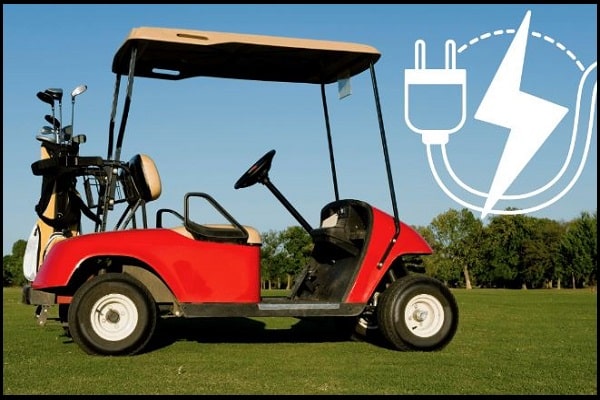A perfectly timed golf weekend ruined by a sluggish golf cart? The culprit might be a malfunctioning battery. And you might be wondering, why is your golf cart charger not working. But don’t worry. This is a common issue. In most cases, it’s a fix you can tackle yourself.

If your golf cart charger isn’t working, start by checking the power source and ensuring the outlet is functional. Inspect the charger connections for any loose terminals that could impede power flow. Verify that the charger is compatible with your golf cart’s battery type and voltage. Lastly, examine the charger itself for any signs of damage or internal issues, and consider testing with a different charger to pinpoint the problem.
We’ll explore the most likely reasons your charger isn’t delivering the juice it should, along with some easy troubleshooting steps to get you back to cruising the course with confidence. So, grab your tools, and let’s diagnose why your golf cart battery charger is not working.
Why is Your Golf Cart Charger Not Working?
The most common reason your golf cart charger isn’t working is a dead or weak battery. Chargers typically require a minimum voltage from the batteries to function. If the batteries are completely drained, the charger won’t even turn on.
What to Do if Your Golf Cart Battery Charger isn’t Working
Let’s explore some troubleshooting steps to get your golf cart back on the Golf course:
- Check the battery voltage. Invest in a simple voltmeter to measure the total voltage across all your batteries. It should be at least 25-30 volts for the charger to kick in. If it’s lower, you might need to jump-start the batteries or replace them altogether.
- Inspect the connections. Loose, corroded, or dirty connections between the charger, cables, and batteries can disrupt the flow of electricity. Tighten loose connections, clean any corrosion, and ensure everything is properly plugged in.
- Look for blown fuses. Some chargers have built-in fuses that can blow if there’s a surge. Consult your charger’s manual to locate the fuse and check if it’s damaged. Replace it if necessary.
- Consider the Onboard Computer (OBC) on Club Car models. If you have a Club Car manufactured after 1995, the OBC regulates battery charging. A malfunctioning OBC can prevent the charger from working properly.
- Look for visible damage. Inspect the charger for any physical signs of trouble, like burns, melted parts, or frayed wires. If you see anything concerning, it’s best to consult a golf cart professional.
Golf Cart Charger Maintenance Tips From the Experts
- Keep it cool and dry. Store your charger in a shaded area to avoid overheating. Don’t leave it plugged into the cart when not in use.
- Clean is key. Dust buildup on the vents can reduce airflow. Use compressed air to clean the vents occasionally.
- Inspect the cord. Regularly check the charger cord for damage. A frayed cord is a fire hazard – replace it immediately.
- Don’t overcharge the battery: Charge just a single cart at once. As directed by the manufacturer.
You can maintain the smooth operation of your golf cart charger for many years by following these easy procedures.
For an accurate diagnosis and repair, seek the advice of a trained golf cart mechanic if you are uneasy diagnosing and fixing electrical components. They are able to identify the precise problem and repair your golf cart charger.
A broken golf cart charger may make you long for open fairways. Avoid being irritated. You may identify the cause of your golf cart charger not working by using these professional techniques.
You can regain control of the situation with a little troubleshooting, which includes verifying connections and monitoring battery voltage. Recall to consult a golf cart specialist for complicated electrical issues.
FAQs on Why is My Golf Cart Charger Not Working?
My charger won’t even turn on. What’s wrong?
Dead batteries! Most chargers require a minimum battery voltage (around 25-30 volts) to function. Check your battery voltage with a voltmeter.
The connections look fine. Why isn’t it charging?
Corrosion on the battery terminals can disrupt the flow of electricity. Clean them with a wire brush and baking soda solution.
I hear a buzzing noise, but no charging.
Damaged charger cord! Exposed wires can be dangerous and prevent charging. Inspect the cord for wear and replace it if needed.
No click when I plug it in. Is the charger broken?
Maybe not! Some chargers click with sufficient battery voltage. No click could also indicate a problem with the On-Board Computer (OBC) in some Club Car golf cart models.
I’ve tried everything! What now?
Don’t be a hero! Complex electrical issues are best left to the pros. Call a golf cart specialist for diagnosis and repair.
Can I prevent charger problems?
Regular maintenance helps! Keep your battery terminals clean and connections tight. Avoid letting batteries drain completely.
Lastly, a malfunctioning golf cart charger can leave you yearning for wide-open fairways. Do not get frustrated. You may identify the cause of your golf cart charger not working by using these professional techniques. You can regain control of the situation with a little troubleshooting, which includes verifying connections and monitoring battery voltage.
Remember that a golf cart professional is your greatest ally for complicated electrical issues with golf carts. They’ll get your golf cart cruising and your charger humming in no time. Giving you more time to concentrate on honing your swing.
